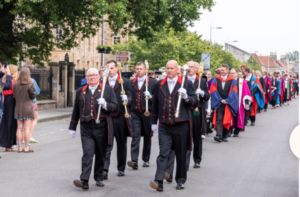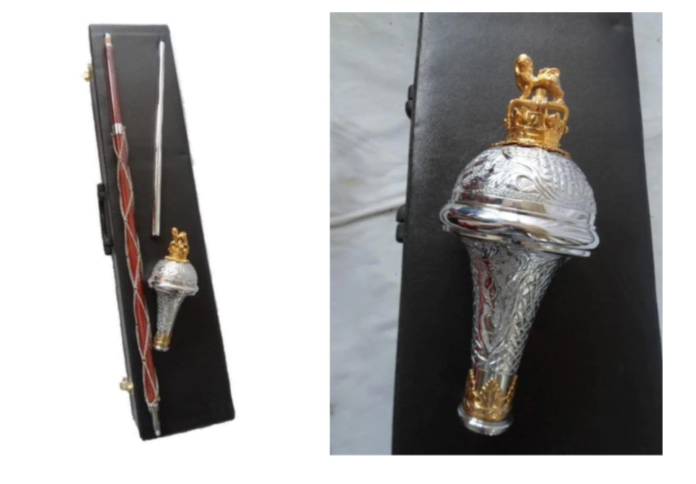The Scottish mace, steeped in history and tradition, stands as a venerable symbol of prestige and power within the cultural landscape of Scotland. From its humble origins as a weapon of war to its modern-day role in ceremonial affairs, the Scottish mace embodies centuries of craftsmanship, symbolism, and heritage. As an integral component of ceremonial regalia, the mace holds a sacred place in Scottish culture, serving as a tangible link to the nation’s storied past and enduring values. In this article, we delve into the rich history, symbolism, and ceremonial significance of the Scottish mace, exploring its evolution from a martial instrument to an emblem of authority, and examining its role in contemporary society. Join us as we unravel the mysteries and marvels of this iconic symbol of Scottish identity and tradition.
Historical Significance of the Scottish Mace
Origins of the Scottish Mace
The origins of the Scottish mace date back to the medieval period, a time characterized by feudalism, warfare, and the consolidation of power among nobility. Initially, the mace served a practical function as a weapon of war, wielded by knights and soldiers in battle. Constructed from sturdy materials such as iron or steel, early Scottish maces were designed to deliver devastating blows to armored opponents, making them formidable instruments of combat on the battlefield. As feudal society evolved and centralized authority began to emerge, the role of the mace shifted from a purely martial tool to a symbol of civic authority and governance. By the late Middle Ages, Scottish maces had become fixtures in the ceremonial regalia of municipal governments, guilds, and royal courts, signifying the authority vested in elected officials and civic leaders. Adorned with intricate carvings and heraldic emblems, these maces conveyed prestige and power, reflecting the status and influence of the institutions they represented.
Evolution of Its Design
Over the centuries, the design of the Scottish mace underwent significant transformations, mirroring shifts in artistic styles, technological advancements, and cultural preferences. Early maces were often plain and utilitarian in appearance, with simple shafts and blunt heads designed for maximum impact in close combat. However, as craftsmanship flourished and decorative techniques improved, maces began to incorporate elaborate embellishments, including engraved patterns, precious metals, and gemstones. During the Renaissance period, Scottish maces reached new heights of artistry and sophistication, reflecting the prevailing aesthetic tastes of the time. Inspired by classical motifs and architectural forms, craftsmen adorned maces with intricate filigree work, scroll patterns, and figurative sculptures, transforming them into objects of exquisite beauty and craftsmanship. These ornate maces became prized possessions of royalty, aristocrats, and dignitaries, symbolizing wealth, status, and cultural refinement.
Symbolism of the Scottish Mace
Representation of Authority
At its core, the Scottish mace symbolizes authority and leadership, serving as a tangible manifestation of the power vested in elected officials and civic institutions. When wielded by a magistrate or ceremonial officer, the mace commands attention and respect, conveying a sense of gravitas and solemnity befitting the occasion. In parliamentary settings, the presence of the mace serves as a visual reminder of the rule of law and the responsibilities entrusted to elected representatives, reinforcing the democratic principles upon which modern governance is based.
Connection to Scottish History and Culture
Embedded within the intricate carvings and symbolic motifs of the Scottish mace are echoes of Scotland’s rich history and cultural heritage. From Celtic knotwork to heraldic symbols, each element of the mace tells a story of the nation’s past, reflecting its triumphs, struggles, and enduring spirit. Whether adorned with thistles, lions rampant, or royal crowns, Scottish maces evoke a sense of national pride and identity, celebrating the traditions and values that have shaped Scottish society for generations.
The Ceremonial Use of the Scottish Mace
Role in Parliamentary Proceedings
In the context of parliamentary proceedings, the Scottish mace plays a vital role in maintaining order and decorum, symbolizing the authority of the legislative body and the sovereignty of the people. Positioned prominently within the debating chamber, the mace serves as a focal point for deliberation and debate, reminding lawmakers of their solemn duty to represent the interests of their constituents. When the mace is present, parliamentary business may proceed, but in its absence, no formal proceedings can take place, underscoring the significance of this ancient symbol of parliamentary authority.
Use in Formal Events and Ceremonies
Beyond the confines of the parliamentary chamber, the Scottish mace is often featured in a wide range of formal events and ceremonies, where it adds a touch of grandeur and solemnity to proceedings. Whether carried in royal processions, academic convocations, or civic parades, the mace serves as a visual focal point, capturing the attention of onlookers and dignitaries alike. As a symbol of continuity and tradition, the mace reinforces the sense of pageantry and spectacle that accompanies such occasions, connecting the present with the storied past of Scottish culture and heritage.
Notable Scottish Maces
Examples from Various Institutions
Across Scotland, numerous institutions boast their own unique Scottish maces, each with its own distinct history and significance. From the ancient universities of St. Andrews, Glasgow, and Edinburgh to the venerable guilds of craftsmen and artisans, these maces serve as tangible reminders of the contributions made by their respective institutions to the cultural and intellectual life of the nation. Often crafted by renowned artisans and master craftsmen, these maces are revered for their historical importance and artistic merit, attracting visitors from far and wide who seek to marvel at their beauty and craftsmanship.
Unique Features and Historical Contexts
Many Scottish maces are distinguished by their unique features and historical contexts, which offer valuable insights into the social, political, and cultural dynamics of their time. For example, the mace of the Royal Burgh of Edinburgh, dating back to the 16th century, bears the inscription “Nisi Dominus Frustra” (“Except the Lord in vain”) and is adorned with the coat of arms of the city, reflecting Edinburgh’s status as the capital of Scotland and the seat of royal power. Similarly, the mace of the University of St. Andrews, dating back to the 15th century, is adorned with symbols of learning and scholarship, underscoring the university’s role as a bastion of knowledge and enlightenment in medieval Scotland.

Discovering Scotland’s Treasures
In addition to its historical significance, the Scottish mace holds a prominent place within the vibrant tapestry of Scotland’s cultural heritage. For those seeking to immerse themselves in the rich traditions of Scotland, a visit to a reputable Scotland shop offers an unparalleled opportunity to experience the nation’s iconic symbols and symbols firsthand. From tartan kilts and bagpipes to intricately crafted maces, these shops showcase a diverse array of Scottish treasures, each imbued with its own unique history and symbolism. Whether browsing for souvenirs or searching for authentic Scottish attire, visitors to a Scotland shop are sure to find an array of meticulously crafted mementos that capture the essence of Scotland’s proud heritage.
Preservation and Maintenance of Scottish Maces
Conservation Efforts
In recognition of their cultural significance and historical importance, concerted efforts are underway to preserve and protect Scottish maces for future generations. Conservationists employ a variety of techniques and methodologies to ensure the long-term stability and integrity of these precious artifacts, including climate control, specialized cleaning, and restoration. By employing best practices in conservation science and heritage management, experts strive to safeguard these invaluable relics of Scotland’s past, ensuring that they remain accessible and appreciated by audiences around the world.
Importance of Heritage Protection
The preservation of Scottish maces is not merely a matter of historical interest but a vital aspect of cultural heritage protection. By safeguarding these artifacts from damage, decay, and neglect, society can continue to appreciate and celebrate the rich tapestry of Scotland’s past for years to come. Moreover, the preservation of Scottish maces serves as a testament to the enduring legacy of Scotland’s cultural heritage, highlighting the importance of safeguarding these treasures for future generations to cherish and enjoy.
Conclusion
In conclusion, the Scottish mace stands as a timeless symbol of prestige, power, and tradition, embodying the spirit of Scotland’s storied history and cultural heritage. From its origins as a weapon of war to its modern-day role in ceremonial affairs, the mace serves as a tangible link to the past, reminding us of the traditions and values that define our shared identity. As custodians of Scotland’s cultural legacy, it is incumbent upon us to preserve and protect these invaluable artifacts for future generations, ensuring that they continue to inspire awe and admiration for centuries to come.
Unique FAQs
- What is the significance of the symbols engraved on Scottish maces?
– The symbols engraved on Scottish maces often represent elements of Scottish history, culture, and identity, serving as visual reminders of the nation’s heritage. From heraldic emblems to religious motifs, these symbols convey layers of meaning and symbolism that enrich our understanding of Scotland’s past.
- How are Scottish maces used in contemporary society?
– Scottish maces are primarily used in formal ceremonies, including parliamentary proceedings, academic convocations, and royal events, where they symbolize authority and tradition. Additionally, many Scottish maces are on public display in museums and historic sites, where they serve as educational tools and cultural artifacts.
- Are Scottish maces still crafted using traditional methods?
– While some Scottish maces are still crafted using traditional methods, such as hand forging and metalworking, many modern examples incorporate contemporary materials and techniques to meet modern standards of craftsmanship and durability. However, artisans and craftsmen continue to draw inspiration from historical designs and techniques, ensuring that each mace reflects a timeless commitment to quality and artistry.
- What measures are taken to ensure the preservation of Scottish maces?
– Conservationists employ a variety of techniques, including climate control, specialized cleaning, and restoration, to ensure the long-term preservation of Scottish maces. Additionally, institutions may implement policies and procedures to minimize the risk of damage and deterioration, such as limiting exposure to light and humidity and providing secure storage facilities.
- Can Scottish maces be viewed by the public?
– Yes, many Scottish maces are on public display in museums, galleries, and historic sites across Scotland, allowing visitors to appreciate their beauty and historical significance firsthand. Additionally, some institutions may offer guided tours or educational programs that provide further insight into the role of Scottish maces in the nation’s cultural heritage.


